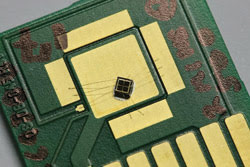Another solar record has been set, and, once again, a unique design is involved.
QuantaSol Ltd. of Surrey, UK, recently announced a record efficiency of 28.3 percent for a single-junction solar cell aimed at use in concentrating photovoltaic systems. What sets this design apart is the use of quantum well structures within the solar cell.
The design uses gallium arsenide phosphide (GaAsP) for the barriers, which, according to its developer Keith Barnham, has a smaller lattice constant; the wells are indium gallium arsenide (InGaAs). Barnham, also the founder of QuantaSol, explained that the combination “balances the strain between the well and the barrier,” adding that putting enough wells in a cell increases absorption.

Quantasol’s 1.2-mm2 cell was exposed to 2000-sun concentration as part of the test.
“The great thing is that, while this trick works with single junctions, it works even better in tandem and triple-junction cells,” Barnham reported. What is most important is the tunability, he said. When electricity is generated from a series of cells, the current usually is derived from the worst-performing cell. By adding quantum wells, the absorption can be tuned to optimize the tandem cell to produce at the highest efficiency, a capability that can be extended to location or time of day, deriving “not just high efficiency, but the best energy yield.”
The ability to adjust each subcell for the optimum bandgap for a given spectrum is extremely important for concentrating photovoltaics because, as Barnham pointed out, a concentrating system is mostly lenses or mirrors. “You have to move the whole module to keep the sun on the cell.” By tuning the bandgap, the system can be optimized for the best energy harvest in a specific location over an entire year.
The team is working on developing a multijunction cell and expects to have samples in the first quarter of 2010 and volume production by the end of that year. Prices are expected to be very competitive, according to Kevin Arthur, chief executive officer.
“The business model we have with foundries has convinced us,” he said.